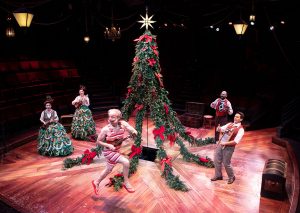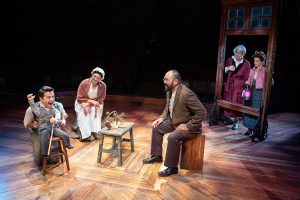Scrooge Shows Up For the Holidays, Just Next Door to Globe’s Grinch
Standing outside the Old Globe Theatre in the cool, crisp early winter evening lit by twinkle lights and ringing with chatter from little girls in velvet party frocks rushing to their rendezvous with The Grinch, somebody in the Globe management must have begun pondering that, just next door, there lurked a second playhouse, cold and dark.
That would never do, in this season when Globe shows are designed to train future audience while tapping family holiday budgets to brighten the year-end balances. Surely there must be some way to use the arena stage too?
Thus, even now ambitious showfolk are rummaging through O. Henry and comic strips and fairy tales and maybe even second-string Dr. Seuss, seeking the legendary small-cast holiday extravaganza that will secure fortunes for all.
Until then, there’s always Dickens. Especially his little gold-mine, A Christmas Carol.
Dickens always wanted to write a play, but his talent lay elsewhere. He was, apparently, a mesmerizing storyteller and one of the cornerstones of his career as a beloved stage raconteur was the Christmas Eve conversion of old Scrooge the miser into the Author of the Feast.
Scrooge was a staple in many a movie and not unknown on the English-speaking stage but it wasn’t until the 1970s that regional playhouses, watching the way ballet companies paid bills with an annual Nutcracker, begin to enlist Dickens as their own Tchaikovsky.
The Guthrie Theatre in Minneapolis mounted their own commissioned version in 1974. Within a decade, the show was everywhere in all sorts of versions. Important elements of the 1843 original – ghostly visits to miners and lighthouse keepers, for example – and other changes such as a Scrooge visit to the Cratchit household, became so firmly attached that readers of the original now are often confused.
The San Diego Repertory Theatre brought the work to modern San Diego stages in its first season, 1976, adapted by Douglas Jacobs. Thereafter, the company made Carol an annual event, substantially rewritten by Jacobs every two years, for 25 seasons.
The Old Globe did a Christmas Carol in its fourth season – 1938 – and again in 1949, after World War II. There was talk of a Globe revival in the 1980s, but nothing more came of it and the tradition has been picked up by other San Diego companies.

Cathryn Wake, Jacque Wilke, Robert Joy, Orville Mendoza and Dan Rosales, left to right, in Ebenezer Scrooge’s BIG San Diego Christmas Show at the Old Globe. Jim Cox photo
Until now. These days, the White Theatre keeps the same hours as the Grinch next door with an attraction titled Ebenezer Scrooge’s BIG San Diego Christmas Show, an adaptation by Gordon Greenberg and Steve Rosen, staged by Greenberg and featuring five hard-working actors with a large serving of theatre magic.
There’s some Dickens, some garbled San Diego history and many a Victorian reference, but there’s rather too much generic knockabout humor of the simplified topical sort:
Miser Scrooge to the ladies seeking donations for the mission: “Tell the Padres they’ve struck out!”
Somebody needs medical care: “Call Dr. Kaiser!” “He’s leaving town.” “We’ve got to make him more permanente.”
That sort of thing.
Greenberg the director has everybody rising above the writing of Greenberg (and Rosen) the author, selling the dear old tale as best they can with poise and infectious good will.
Robert Joy, a familiar Globe face, is pretty much the scrooge to be expected from a lean and experienced character man. Orville Mendoza and Dan Rosales play all the other gents while the women young are pertly offered by Cathryn Wake and Jacque Wilke rounds off with the older and softer females. Everybody contributes narration and music (ukuleles and mandolins) as needed.

From the left, Dan Rosales, Jacque Wilke, Orville Mendoza, Robert Joy as Scrooge and Cathryn Wake in Ebenezer Scrooge’s BIG San Diego Christmas Show at the Globe. Jim Cox photo
Tiny Tim is a partial puppet and Rosales’ falsetto. The Christmas tree grows eloquently from a trap door center stage and, more impressive, returns there when done. Candy and bells are thrown into the crowd.
Adam Koch’s scenery is bright, cheerful and slyly the trickster. Amanda Zieve’s lighting uses a holiday palette and Bart Fasbender makes with the spooky sounds quite adeptly.
It is the David Israel Reynoso costumes, spic and span in Globe fashion, that join the writing of the script to give me pause.
There are indications that the scene is set in San Diego a century ago, yet the top hats, the long skirts and tight waistcoats suggest another era entirely. San Diego in 1919 was edging toward flappers and bootleg booze. There were cars in the streets and airplanes overhead. And, contrary to some prominent conversational threads here, there were theaters. Eleven of them, in fact, and probably some showing seasonal fare that Christmas Eve. If the idea is to whisk us back 100 years, then a bit of simple research might suggest even more fun to be had beyond Victorian traditions.
And I can’t help mentioning that a large part of Dickens’ inspiration for the writing of this classic was his distress at the deplorable child-abuse so shameful at the time. True, this doesn’t make the cut for most Carol adaptations anymore, but it does seem unfortunate that, in a time so plagued by an assortment of inhumanities, there couldn’t be some bitter to balance the sweet.
But no. Dickens has long since been prettied up and placed prominently upon the nostalgia shelf. So, let the celebration proceed.
(Continues in the Old Globe’s Sheryl and Harvey White Theatre, Balboa Park, at 7 p.m. Tuesdays-Sundays and at 2 p.m. Saturdays and Sundays through Dec. 29, 2019.)

Welton Jones has been following entertainment and the arts around for years, writing about them. Thirty-five of those years were spent at the UNION-TRIBUNE, the last decade was with SANDIEGO.COM.


